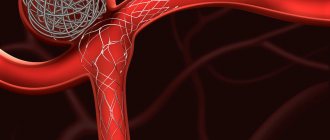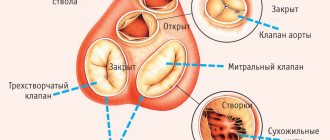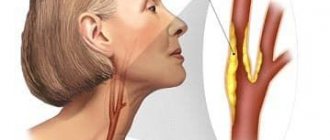An aneurysm is a pathological condition in which the walls of arterial vessels are stretched. With a cerebral aneurysm, intracranial vessels are damaged.
The disease occurs in 2 types:
- course of the disease according to the type of tumor;
- course of the disease with rupture of the vessel.
The course of the disease according to the type of tumor is characterized by a symptom of compression. The aneurysm increases in size and damages the cranial nerves (oculomotor, trigeminal, facial). The course of the disease with rupture of the vessel is characterized by hemorrhage into the subarachnoid space or into the substance of the brain.
The diagnosis is made on the basis of complaints, anamnesis, clinical symptoms, computed tomography, MRI, and x-ray data. If there are indications for removal surgery, surgical treatment is performed: clipping and endovascular removal. Since 1999, the 10th revision of the classification of international diseases has been introduced in Russia. Aneurysm of cerebral vessels has a personal code according to ICD-10 I67.1.
Prevalence
The exact prevalence of the disease cannot be determined. Aneurysm often occurs without any specific or nonspecific symptoms. It is possible to detect such damage only after the death of a person at an autopsy; 50% of cases are found in this way.
The prevalence of aneurysm in the world is 10-15 people per 100,000 population.
After rupture of an artery into the subarachnoid space, the immediate mortality of patients is 15%. 25% of patients with ruptures will die within the first 2 days after the incident, and 50% within the next 3 months. An aneurysm can appear in a person or be present from birth. The rupture occurs at the advanced age of 60 years.
Causes
The main link in the pathogenesis of the disease is the thinning of the layers of the vascular wall. The wall cannot resist and adapt to blood pressure and begins to stretch. The stretching accelerates due to the filling of the cavity with blood, and a vortex blood flow is formed.
The reasons that trigger the process can be various diseases:
- inflammatory diseases of the membranes of the brain, meningitis lead to the destruction of the layers of the artery wall, it becomes less plastic;
- damage to the skull and brain;
- the presence of a focus of infection, which may not be located in the brain, for example, syphilis, infective endocarditis (the pathogen enters the skull with the general bloodstream);
- high blood pressure leads to thinning of arterial vessels;
- diseases with impaired immune response - systemic lupus erythematosus;
- dyslipidemia, which leads to the formation of atherosclerotic plaques in the body;
- neoplasms that can grow into the head arteries, but may not be located near the brain and damage the vascular wall with their decay products.
General information about arterial aneurysms
An aneurysm is a local expansion of a vessel with gradual thinning of its wall. The process is irreversible; over time, under the influence of blood flow pressure, the protrusion only increases and, one day, may rupture. This leads to internal arterial bleeding. Without timely medical attention, a ruptured aneurysm leads to death.
Other possible complications include: thrombosis, thromboembolism (when a blood clot breaks off and clogs other vessels), infection of the aneurysm.
Clinical manifestations of aneurysm
The main symptoms are associated with the large size of the aneurysm. It begins to compress the brain tissue. Therefore, if the sizes are small, then there will be no signs of the disease. Diagnosis of an aneurysm in this case is random.
With rapid growth of the formation, symptoms appear:
- pressing severe headache;
- dysfunction of the brain, speech, vision, hearing;
- the appearance of spots before the eyes;
- dizziness that occurs at rest or with minor physical exertion;
- loss of memory, attention, concentration;
- vomiting, nausea, dysphagia;
- constant fatigue, fatigue;
- seizures.
The aneurysm may rupture. This is influenced by several reasons: a rapid increase in blood pressure, a stressful situation, injury, fever, nicotine or alcohol abuse.
When a rupture occurs, the person most often loses consciousness and becomes comatose. The severity of the disease depends on the size and location of the formation. If the aneurysm was in the subarachnoid space, then there will be a subarachnoid hematoma. Clinically, this will manifest itself as compression symptoms. If the location of the vascular protrusion was in the substance of the brain, a hemorrhagic stroke will occur. This is a more serious condition.
Symptoms of a ruptured aneurysm:
- severe headache;
- dizziness;
- nausea, vomiting;
- impairment of consciousness, speech, vision, hearing, coordination;
- convulsions.
At the first symptoms of a rupture, it is necessary to take the person to the hospital or call an ambulance. First aid consists of laying the patient down with an elevated head, ensuring a flow of fresh air, unbuttoning and removing all clothing that prevents the person from breathing, and checking the patency of the upper respiratory tract.
What is the cost of the operation
Due to the fact that clipping an aneurysm is a very complex and dangerous operation, it is not performed in all major cities of Russia. Thus, clinics with appropriate personnel and technical equipment exist in Moscow, Tyumen, Ufa, Kirov, Volgograd, Krasnodar and some other regional centers.
Regarding the cost of the operation, it should be noted that a planned intervention can be performed according to a quota allocated from the funds of the Ministry of Health of the Russian Federation, but for this the patient must contact the regional department of the Ministry of Health and provide all documents confirming the need for the intervention.
In the event that the patient does not intend to wait several weeks or months, he can be operated on in any city at his own discretion, but at his own expense. The cost of operations depends on many factors and ranges from 12 thousand rubles to 180 thousand rubles for endoscopic surgery and from 22 thousand rubles to 170 thousand rubles for clipping an aneurysm.
aneurysm before/after surgery
Diagnostics
The disease is often asymptomatic, so detecting a cerebral aneurysm is difficult. The doctor should think about the presence of this formation in the patient if he has severe headaches, dysfunction of brain structures, or seizures.
If suspected, the patient is referred to special instrumental research methods: CT, MRI, X-ray, electroencephalography.
The most important and informative methods are computed tomography and magnetic resonance imaging. In the pictures you can see the parameters of a cerebral aneurysm:
- dimensions;
- location;
- thrombus formation;
- hemodynamics inside the formation.
X-ray examination with the introduction of a contrast agent into the vessels of the brain has a high diagnostic value. On an x-ray, you can see the thickness of the vascular wall, the presence of a thrombus in the lumen of the vessel, stretching of the intima and adventitia of the arteries.
X-ray allows for a differential diagnosis in the early stages of the disease and to distinguish a malignant neoplasm from a cerebral aneurysm. X-ray radiation, even in small doses, affects the body with the appearance of negative effects. For pregnant women, pediatric patients, and patients with other diseases, it is preferable to undergo CT and MRI.
Electroencephalography records the biological potentials of the brain and shows the activity of white and gray matter. If brain function abnormalities are detected by EEG results, the patient may be suspected of having a cerebral aneurysm and sent for additional studies, for example, MRI, where the diagnosis of I67.1 will be confirmed. Electroencephalography does not have negative effects on the human body.
Classification of the disease
Experts distinguish between two types of disease: arterial and arteriovenous aneurysm, of which arterial aneurysm is the most dangerous. Aneurysms are classified according to these parameters:
1. By configuration:
- saccular;
- spindle-shaped.
2. By location:
- anterior cerebral artery;
- internal carotid artery;
- vertebrobasilar system;
- middle cerebral artery;
- multiple localizations.
3. By size of education:
- gigantic size;
- large;
- medium size;
- small;
- miliary.
Treatment of cerebral aneurysm
Treatment for such a vascular defect involves surgery and removal of the aneurysm. The operation is considered a mandatory procedure if the size of the protrusion reaches 7 mm. During the operation, the defect is removed and the integrity of the brain vessels is restored. There are several methods of surgical operations for this disease: clipping and endovascular removal.
Clipping
Clipping, a microsurgical operation, is the most commonly used method for treating unruptured aneurysms.
The essence of the operation is that the surgeon opens the skull, finds the location of the aneurysm and removes it. The operation carries great risks for the patient's life. The surgical intervention consists of several stages:
- Opening the integrity of the skull. The location of trepanation depends on where the vascular defect is located. Most often, trepanation is performed in the parieto-occipital region.
- Then the membranes of the brain are separated with a scalpel: hard, arachnoid, soft.
- The third step is to find the aneurysm and remove it. This stage is the most critical; the protrusion must not be allowed to rupture. Hemorrhage into the brain matter can lead to the death of the patient. To prevent rupture, a staple or clip is placed at the base of the defect, and the aneurysm is cut off and removed from the skull.
- The final stage is exit from the wound. It is necessary to apply stitches in the correct sequence.
Endovascular removal
Endovascular operations are performed only in high-tech centers. This manipulation requires special specialized equipment, as well as qualified specialists. The MEDSI clinic meets all the requirements for performing endovascular aneurysm removal surgery.
Craniotomy is not performed for this type of operation. The surgeon reaches the aneurysm through the great vessels. The catheter is inserted into the carotid or femoral artery and advanced to the brain. The operation is performed under the control of Doppler ultrasound or CT. The needle with the catheter is brought to the aneurysm, with the help of balloons it is switched off from the general blood flow, and the surgeon removes the aneurysm.
There is another way to separate the aneurysm from the general blood flow. A special chemical is released into the artery, which reaches the protrusion in the brain, forming emboli in the artery.
The highly specialized technology has a number of advantages:
- there is no need to make penetrating wounds of the skull, this contributes to less trauma to the patient;
- the postoperative period is halved;
- The patient does not require general anesthesia;
- if the aneurysm is located near the brain stem or in its depth, it can only be removed using endovascular surgery.
The operation may contain modifications and proprietary techniques.
Every operation carries a risk of complications. With endovascular removal of a cerebral aneurysm, complications are also possible:
- spasm of the arteries, ischemia of areas of the brain;
- rupture of protrusion of an iatrogenic nature;
- blood clot formation in an artery;
- death of a patient for an unknown reason during a removal operation.
Contraindications for surgery
The tactics of surgical treatment in patients with hemorrhage is determined on the basis of a scale developed specifically for neurosurgeons (Hunt and Hess scale (1968); WFNS SAH Scale (1988)). The main criteria here are the presence of clinical manifestations of an aneurysm, motor or speech disorders, as well as vascular spasm in the patient (angiospasm), diagnosed based on the results of an X-ray contrast study. Thus, in a patient with severe vasospasm, one should refrain from surgery, since the risk of postoperative complications outweighs the benefits of surgery.
In addition, the operation is contraindicated if the patient has severe acute somatic diseases or decompensation of chronic diseases - acute infectious process, blood clotting disorder, severe diabetes mellitus, severe exacerbation of bronchial asthma, etc.
Postoperative period
After surgery, the patient may experience consequences from removal of a cerebral aneurysm:
- noise in ears;
- loss of vision or loss of visual fields;
- incoordination;
- dizziness and frequent headaches;
- anxiety, malaise, increased irritability;
- fast fatiguability.
The most common problem in the postoperative period is thrombus formation. After applying a clip or suture to a vessel, atherosclerotic plaques may settle, which will close the lumen of the vessel and lead to cerebral ischemia.
Also, in the early period after surgery, the sutures may come apart, which threatens hemorrhage into the medulla or subarachnoid space.
Risk factors for developing aneurysms
The development of aneurysms is predisposed by the loss of elasticity and strength of the vessel wall. Weakness of the vascular wall may be due to congenital characteristics or the influence of external factors. The main reasons for the development of the disease:
- atherosclerosis - formation of cholesterol plaques;
- inflammation of the aortic wall (occurs with traumatic injury, syphilis, fungal infection);
- autoimmune diseases;
- congenital pathologies of connective tissue (cystic fibrosis, Marfan syndrome);
- trauma during diagnostic and therapeutic procedures (coronary angiography, heart surgery).
Rehabilitation process of patients
A patient who has suffered a rupture of a cerebral vascular protrusion requires rehabilitation. Methods used in the rehabilitation course:
- if the patient has muscle paralysis and is in a supine position, splints are used;
- carrying out massage procedures;
- rehabilitation using applications containing clay and ozokerite.
If there are indications for the use of physiotherapeutic procedures, they are included in the general rehabilitation course.









